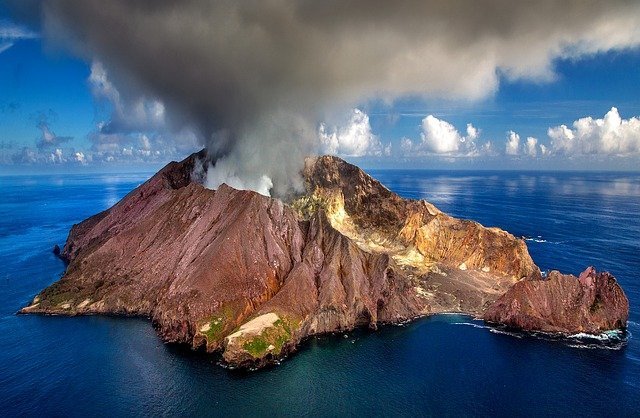Obraz Julius Silver z Pixabay
All the processes that cause earthquakes, the formation, and eruption of volcanoes take place in the depths of the Earth. Deep beneath the Earth's surface, magma forms - a liquid mixture of molten rock, gas, and water. The enormous pressure inside the Earth squeezes magma, gases, and geothermal waters onto the Earth's surface. In this case, we are dealing with the formation of eruption of an already existing volcano. A volcanic eruption is the discharge or ejection into the atmosphere of magma, gases, ashes, and other pyroclastic materials. A volcanic eruption also causes an outflow of magma (molten rock) onto the Earth's surface from volcanic cones or fissures. Often volcanic eruptions are accompanied by strong tectonic shocks. When the lava is dense, volcanic eruptions are very violent (Mount Etna). There are also high volcanic cones. When the lava is scarce, eruptions are less violent (e.g. in Hawaii) and the lava flows rapidly from a volcanic cone that is relatively low and disc-shaped. Volcanoes are most often formed in subduction zones, and then magma is formed from molten rocks of plunging lithospheric tectonic plates. The subduction zone, in the simplest terms, is the zone of collision of tectonic plates causing one tectonic plate to sink under the other. An example of a subduction zone is the coast of Japan. Volcanoes also arise in spreading zones, i.e. places where the earth's crust is formed, and the lava coming out of them comes from the Earth's mantle. This lava is less dense and volcanic eruptions are less violent. Hawaii is an example of a spreading zone. The last, rarest place where volcanoes are formed is the so-called hot spots. Convection currents occurring in the Earth's mantle (downward and upward) can split the Earth's crust and rise to the surface of the Earth. An example of such a volcano is the dormant supervolcano in the Yellowstone National Park in the USA.
Where can we meet volcanoes? As I wrote above in the spreading and subduction zones oeaz over the hot spots. Such zones occur in the enormous ring surrounding the Pacific Ocean. This area is commonly referred to as the Pacific Ring of Fire. It covers the areas of South America and North America, the eastern shores of Asia, and especially the Aleutian, Kuril, Japanese, Philippines and Indonesian archipelagos to New Guinea, Oceania and New Zealand. 90 percent of all volcanoes on Earth are present in the great Pacific ring. Much fewer volcanoes occur in Europe (mainly Iceland and the Mediterranean), Africa (East African Rift and the Canary Islands), Hawaii and the Caucasus Mountains.
^^^^^^^^^^^^^^^^^^^^^^^^^^^^^^^^^^^^^^^^^^^^^^^^^^^^^^^^^^^^^^^^^^^^^
Wszystkie procesy, które powodują trzęsienia ziemi, powstawanie i erupcje wulkanów zachodzą w głębi Ziemi. Głęboko pod powierzchnią Ziemi powstaje magma - płynna mieszanina stopionych skał gazów i wody. Ogromne ciśnienie wewnątrz Ziem powoduje wyciskanie magmy, gazów i wód geotermalnych na powierzchnie Ziemi. W tym wypadku mamy do czynienia z powstaniem lub erupcją już istniejącego wulkanu. Erupcja wulkanu to wypływ lub wyrzucenie do atmosfery magmy, gazów, popiołów i innych materiałów piroklastycznych. Wybuch wulkanu powoduje również wypływ magmy ( roztopionych skał ) na powierzchnie Ziemi z stożków wulkanicznych bądź szczelin. Często erupcjom wulkanów towarzyszą silne wstrząsy tektoniczne. Gdy lawa jest gęsta erupcje wulkanów mają przebieg bardzo gwałtowny ( Etna ). Powstają też wysokie stożki wulkaniczne. Gdy lawa jest rzadka, erupcje mają mniej gwałtowny przebieg ( np na Hawajach) a lawa szybko wypływa ze stożka wulkanicznego który jest stosunkowo niewysoki i przybiera kształt tarczy. Wulkany powstają najczęściej w strefach subdukcji i wówczas magma powstaje ze stopionych skał pogrążających się płyt tektonicznych litosfery. Strefa subdukcji najprościej mówiąć to strefa kolizji płyt tektoniczych powodująca zagłębiane się jednej płyty tektonicznej pod drugą. Przykład strefy subdukcji to wybrzeże Japonii. Wulkany powstają również w strefach spreadingu czyli miejscach powstawania skorupy ziemskiej a wydobywająca się z nich lawa pochodzi z płaszcza ziemskiego. Lawa ta jest rzadszej gęstości a erupcje wulkanów mają mniej gwałtowny przebieg.. Przykładem strefy spreadingu są Hawaje. Ostatnim najrzadziej spotykanym miejscem w którym powstają wulkany to tak zwane plamy gorąca. Występujące prądy konwekcyjne w płaszczu ziemi ( zstępujące i wstępujące ) potrafią rozstąpić skorupę Ziemi i wypłynąć na powierzchnię Ziemi. Przykłądem takiego wulkanu jest uśpiony superwulkan na terenie Parku Narodowego Yellowstone w USA.
Gdzie możemy spotkać wulkany? Jak wyżej napisałem w strefach spreadingu i subdukcji oeaz nad plamami gorąca. Takie strefy występują w ogromnym pierścieniu otaczającym Ocean Spokojny. Powszechnie nazywa się ten obszar pacyficznym pierścieniem ognia. Obejmuje on tereny Ameryki Południowej i Ameryki Północnej, wschodnie wybrzeża Azji, a szczególnie archipelagi Aleutów, Kurylów, Wysp Japońskich, Filipin i Indonezji aż po Nową Gwineę, archipelagi Oceanii i Nową Zelandię. W obszarze wielkiego pierścienia pacyficznego występuje 90 procent wszystkich wulkanów na Ziemi. Znacznie mniej wulkanów występuje w Europie (głównie na Islandii i na Morzu Śródziemnym), Afryce (Ryft Wschodnioafrykański i Wyspy Kanaryjskie), na Hawajach i w górach Kaukazu.
Congratulations @elendeil! You have completed the following achievement on the Hive blockchain and have been rewarded with new badge(s) :
Your next target is to reach 400 upvotes.
You can view your badges on your board and compare yourself to others in the Ranking
If you no longer want to receive notifications, reply to this comment with the word
STOPDO NOT FOLLOW any instruction and DO NOT CLICK on any link in the comment!